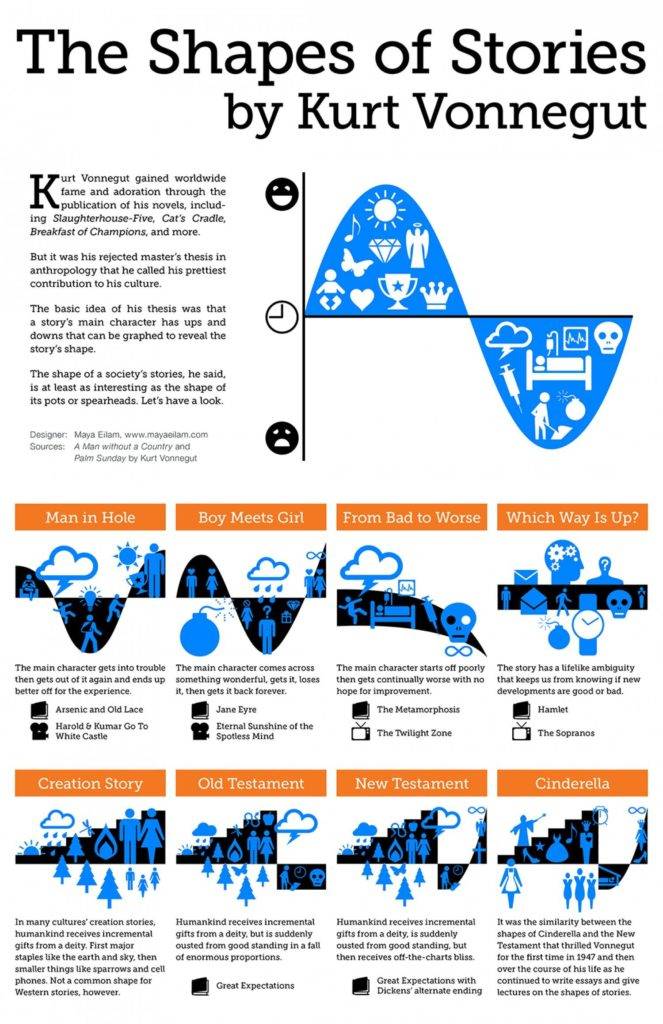Kurt Vonnegut was a master storyteller and storytelling is powerful. Stories resonate with people on a deep, psychological level. Stories are memorable and help support our messages. Hence the speaker’s maxim: Tell a story, make a point.
The best stories contain many elements related to plot, character, dialogue, etc. For some insights into what those elements are, check out these posts on master storytellers Andrew Stanton and Kevin Spacey.
One particular element is the story’s arc or shape. In my previous post, I shared eight tips for writers from Kurt Vonnegut that I believe are applicable to speakers as well. What could be better than a post about Kurt Vonnegut? Two posts about Kurt Vonnegut! So we will once again consult the beloved author for his wisdom on the shape of a story.
In the video below, Vonnegut describes the shapes of three kinds of stories with his unique blend of simplicity and wit.
The three stories that Vonnegut discusses—Man in Hole, Boy Meets Girl and Cinderella—are different kinds of stories, but their shapes are similar one respect. At some point, they all move from “negative territory” into “positive territory”. At some point, the heroes suffer some sort of ill fortune. But in each case they recover and the story ends on a positive note.
It is important to bear in mind that where the stories begin is less important than where they go. As Vonnegut says:
“This is an exercise in relativity. It’s the shape of the curves that matter and not their origins.”
Audiences love this kind of story. The struggle captivates our attention. We suffer with the hero as she works to overcome hardships, we hope that she will prevail and we cheer when she finally does. But this kind of story doesn’t just exist in fairytales. It is a very real part of the business world.
For example, imagine a company representative who has to give a presentation about a project that her department has just completed. The project was a success, but it didn’t start out that way. There were cost overruns, delays in the schedule and general malaise among the employees. But eventually, her team was able to come to grips with these issues and turn the project around.
In the example above, you have a turning point where things went from negative to positive, just like in each of Vonnegut’s stories. And it is usually at the turning point that a lesson is to be found. Why did things turn around? What changed? How can we use this knowledge going forward?
The importance of this concept cannot be overstated. In her Harvard Business Review article, “To Tell Your Story, Take a Page from Kurt Vonnegut“, Andrea Ovans writes:
“[S]o many successful business stories follow patterns embedded in Western civilization’s most primal literary conventions. It’s easy to see why marshalling data to tell one of these kinds of stories – rags turning into riches, mistakes rectified, challenges overcome, the right resources and the right contacts saving the day — would be so compelling.”
Of course, you won’t always have these kinds of stories for every presentation you make. But in my experience working with businesspeople over the years, many people do have them but never think to tell them.
When I push for details, all kinds of wonderful stories pop up. As great as it is to discover such stories, I shudder to think how many remain hidden.
So remember Vonnegut’s lesson and look for stories from your own experience that fit those shapes. You might just be surprised by what you find.

Are these the only kind of story shapes? Of course not. Not every story has a happy ending. To see examples of eight different story shapes, take a look at the infographic below from talented freelance graphic designer Maya Eilam. You can also check out this post by Maria Popova on Brain Pickings.















